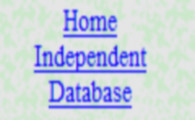| Main Categories |
|
| | More Categories | |
|
|
|
|
Copyright
© 1998-2005
(Free Stuff)
All Rights Reserved
NOTICE: We collect personal information on this site. Find out more
how we use this information and see our Privacy Policy!
|
Editor: Paul Grimes
Free Stuff Home
AUP Policies
|
|
|
Databases |
| More Sub Categories under this Section: |
|
|
|
|
|
|
Last Update: Wednesday, December 30, 2015 At: 9:27:50
(Total Listings: 8) |
Database Basics Part (1)
This tutorial is the first part in the series of database programming primers for web development. Written by Joe Burns, it introduces the basic structure of a relational data base. It explains how data is stored and organized in the DBMS (Database Management System) and how seemingly dissimilar data is related and accessed through the concept of keys.
|
 |
|
(Voting:
5.00 From 5
On
1
Vote!)
Vote!
Why? (Date Listed Thu Jan 1 00:00:00 1970) |
Database Basics Part (2)
This tutorial is the second part in the series of database primers for web development. Written by Joe Burns, it introduces the concept of data type. It then demonstrates the creation of a data table using two methods, using SQL statements or the graphical user interface of Microsoft Access DBMS tool. The tutorial describes both the methods in detail and provides Microsoft Access tool screenshots.
|
 |
|
(Voting:
4.00 From 5
On
1
Vote!)
Vote!
Why? (Date Listed Thu Jan 1 00:00:00 1970) |
Database Basics Part (3)
This tutorial is the third part in the series of database primers for web development. Written by Joe Burns, it introduces the two basic data base SQL statements, INSERT and UPDATE. It demonstrates the usage of each statement for inserting data into a table and updating any table entry. The tutorial also answers some frequently asked questions about SQL and DBMS
|
 |
|
(Voting:
3.00 From 5
On
1
Vote!)
Vote!
Why? (Date Listed Thu Jan 1 00:00:00 1970) |
Database Basics Part (7)
This tutorial is the final part in the series of database primers for web development. Written by Joe Burns, it wraps up the basic SQL database primer series for adding, updating, retrieving and deleting data. It gives pointers on tools and books for further SQL learning. It also lists a series of database projects the reader can take on for additional practice.
|
 |
|
(Voting:
2.50 From 5
On
2
Vote!)
Vote!
Why? (Date Listed Thu Jan 1 00:00:00 1970) |
Database Basics Part (4)
This tutorial is the fourth part in the series of database primers for web development. Written by Joe Burns, it addresses the most important statement in SQL, SELECT. It demonstrates the usage of the SELECT statement for retrieving data from a table. The tutorial also explains the usage of the FROM clause and the WHERE clause used for selective data retrieval.
|
 |
|
(Voting:
2.00 From 5
On
1
Vote!)
Vote!
Why? (Date Listed Thu Jan 1 00:00:00 1970) |
Database Basics Part (5)
This tutorial is the fifth part in the series of database primers for web development. Written by Joe Burns, it explains how to perform sorting, grouping and filtering functions on the data retrieved from the DBMS using the SELECT SQL command. It introduces the LIKE clause for partial database search and describes the ORDER BY, COUNT AS and GROUP clauses for using the inbuilt SQL functions.
|
 |
|
(Voting:
1.00 From 5
On
1
Vote!)
Vote!
Why? (Date Listed Thu Jan 1 00:00:00 1970) |
Basic Database Tutorial Version 0.2.0 June 9 2001
This tutorial provides a basic introduction to databases and database servers. It provides details on the various kinds of databases in use, such as flat file databases, relational databases, object databases and object relational databases. It elaborates on the Object Oriented Database features and standards and explains the frequently used database terminology.
|
 |
|
(Voting:
0.00 From 5
On
0
Vote!)
Vote!
Why? (Date Listed Thu Jan 1 00:00:00 1970) |
Database Basics Part (6)
This tutorial is the sixth part in the series of database programming primers for web development. Written by Joe Burns, it introduces a few more data filtering functions and the essential DELETE command. It explains in detail the usage of basic aggregate functions for counting, averaging or finding the minimum or maximum data entry. It also demonstrates the usage of DISTINCT clause for handling data duplication.
|
 |
|
(Voting:
0.00 From 5
On
1
Vote!)
Vote!
Why? (Date Listed Thu Jan 1 00:00:00 1970) |
|
|
|
|
|

